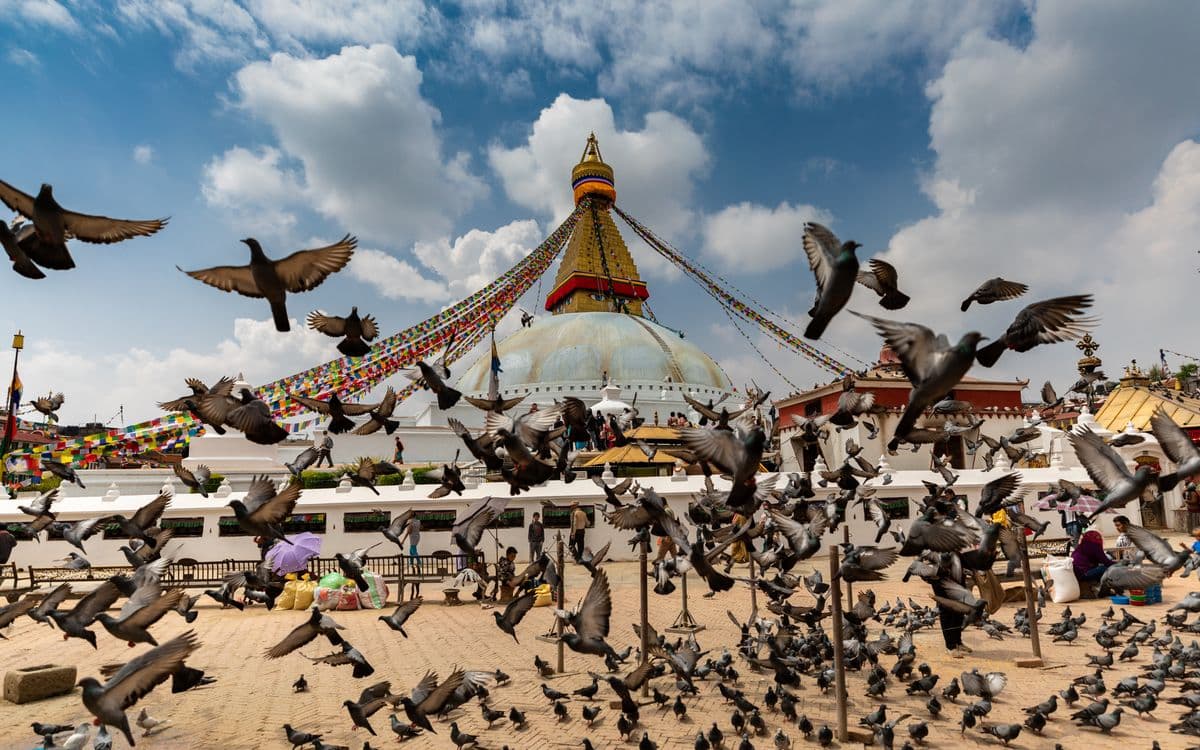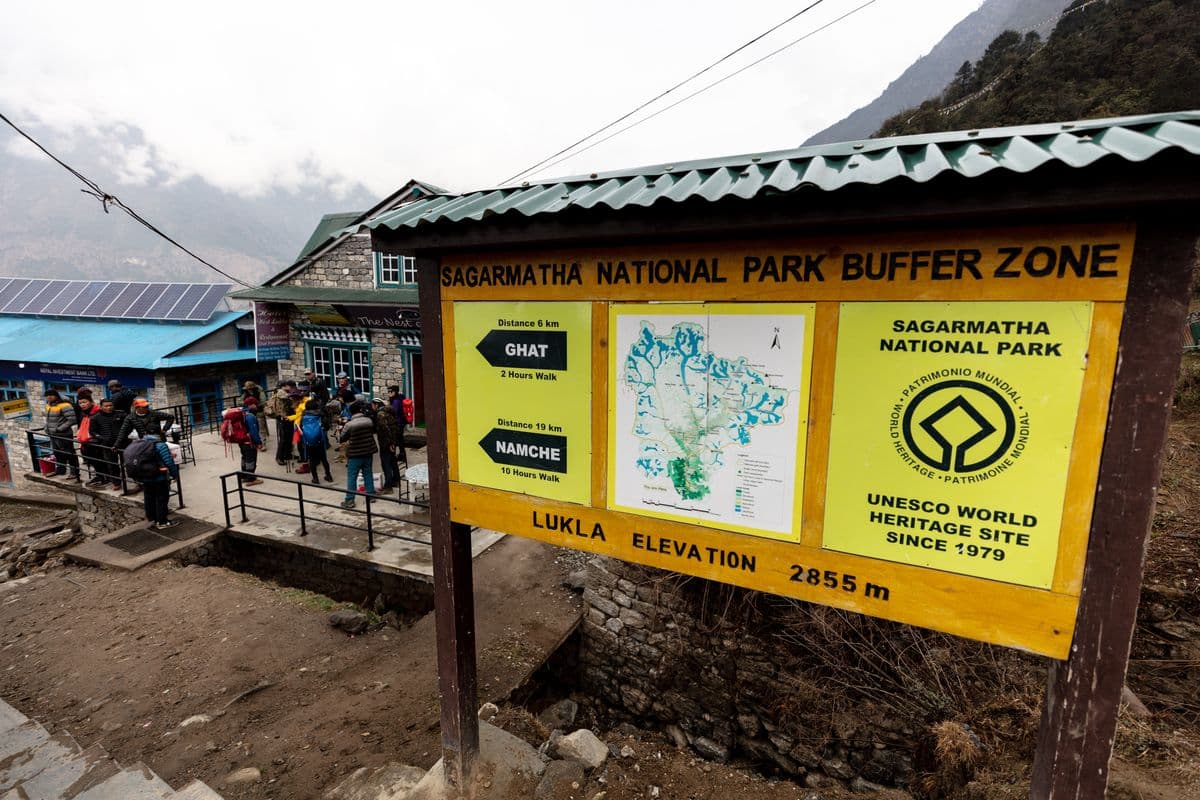

Everest Base Camp Trek in Nepal



This trip is completely customizable
Customize your trip from accommodations to gear to suit your tastes. Begin by creating or adding to a voyage. We're here to help.

Namaste Nepal Trekking & Research Hub
Highlights
Making the approach to the Everest Base Camp, following in the footsteps of famous mountaineers
Visiting the remote mountain villages. Meeting the people from a diversity of ethnic groups like Sherpa, Thakali, Rai, etc, and experiencing the Tibetan Buddhist Culture
Witnessing the raw beauty of the ice floes. Hearing the crash of the snow avalanches and the Roar of running rivers. With a new and more spectacular view day after day!
Waking up on a crystal-clear Himalayan day and seeing 8,000-meter peaks towering over you
Explore the Oldest and the biggest monastery of Khumbu reason, The Tengboche Monastery
Explore the unique lifestyle, culture, tradition, and heart-warming hospitality of the Sherpa’s
Witness panoramic views of the giant Everest massive, including Mt Everest, Mt Lotsce, Mt Nuptse, Mt Thamserku, Mt Aama Dablam. Mt Cho you, Mt Pumori, Mt kongde, Ect
Acend to the Everest base camp with support from our experienced team of guides, crew, and support staff (porters).
Overview
Nowhere in the world is more spectacular than in the Everest region. It is where four of the world's six tallest peaks Mt. Everest(8,848.86m / 29,031), Mt. Lhotse(8,516m / 27,940 ft), Mt. Makalu(8,463m / 27,766 ft), and Cho Oyu(8,188m / 26,864 ft) rise above everything else, The Everest Base Camp trek is the grandest walk in the land of the Himalayas. Trekking through the Everest region offers astounding mountain views, and opportunities to get a glimpse into the life of world-famous climbers (the Sherpas).
TheEverest Base Camp Trek further offers the opportunities to go sightseeing around Sagarmatha National Park, a world heritage site that is home to a variety of Himalayan floras and faunas, to get a closer look at the highest Buddhist monasteries in the world, and, of course, the most gratifying of them all, the trip to Everest Base Camp itself. It is an opportunity to embark on an epic journey that Sir Edmund Hillary and Tenzing Norgay set off on in 1953. But nothing beats the thrill and sense of accomplishment that grips travelers on seeing the power and grace of the mighty Everest up close.
The journey beings with the flight from Kathmandu to the hair-raising Lukla airstrip perched at a lofty 2,860m / 9,383 ft. The small airstrip frequently makes lists of the world’s most dangerous airports and there have been numerous crashes over the years. But you likely are safer making the journey by air than by Nepal’s system of mountain roads with sheep drops into steep canyons, no guardrails, and buses that could be described as “aging” at best. Altitude is an important consideration on the Everest Base Camp trek and nearby Namche Bazar (3,441 m / 11,290 ft), the Sherpa village and gateway to the Khumbu region, is often used as an early layover for rest and acclimatization.
From Namche, the trek heads upward through colorful Sherpa villages along the Dudh Kosi River. Terraced rice fields and rhododendron forests eventually turn into hardened landscapes of rock and ice. On the approach to Everest Base Camp is the final outpost of Gorak Shep; there are no teahouses at Everest Base Camp so trekkers can either day hike from Gorak Shep or bring camping gear. The scramble to nearby Kala Patthar (5,545m / 18,192 ft) offers a panorama of Everest, Lhotse, and Nuptse that bests the views from the base camp itself. The main Everest Base Camp trail is an up-and-back route, meaning that you hike down the same trail you hiked up.
This whole trip will always stay at the bottom of your heart and you will always cheer this memorize and want to make more of them, happy trekking.
Accommodation in Everest Base Camp Trek
Nowadays in the lower elevation of Everest reason have many different category hotels from normal teahouses to Luxury hotels. they are providing the room with attached bathrooms and hot shower and room service. However, teahouses in some places only have shared toilet and washing facilities. There is nothing like falling asleep after a long day on the trails to a panoramic display of mountains outside your bedroom window. On the inside, the accommodation is simple, yet clean, cozy, and functional. The rooms usually include single-sized beds with comfortable sheets, pillows, and blankets. All the Accommodation for your trek and tour is twin sharing basis. If you wish to get a single supplement it will be available in Kathmandu and lower elevation of the trekking area but it might be difficult to get them in higher elevations in peak seasons.
Food in Everest Base Camp Trek
During the Everest Base Camp Trek, you can enjoy traditional Nepali food “Daal Bhaat”, which is a platter of boiled rice, curry, Greens, lentil soup, and pickles is available everywhere, as well as many types of International (Indian, Chinese, Italian, Continental, Tibetan, etc) foods.
For breakfast, you can choose items of bread, eggs, porridge, muesli, Corn flakes, pancake, hash browns, fries, Chapati, etc. The lunch and dinner menu is the same, which includes items of some vegetables and meats (limited option), spaghetti, pizza, noodles, sandwich, burgers, Soup, momo, etc are common foods. The fruit is rare and you don’t find any seafood items on the menu.
You can also find simple choices of hot beverages that include different types of tea, coffee, hot chocolate, hot lemon with Ginger and honey, etc. In some places, you can also find a simple dessert menu that includes apple pie, chocolate roll, custard, and pudding. Breakfast and Dinner we will take wherever we stay and the Lunch we will take on the way to our Destinations.
Our Trekking Team for Everest Base Camp Trek
Your safety is our first priority. To make your dream adventure come true and successful there will be 1 professional trekking leader/guide, 1 assistance trekking guide (1 assistance trekking guide for every 7 trekkers), and support staff / Sherpa porters (1 support staff for every 2 trekkers). These arrangements will make sure that if anybody on the group gets any issue (emergency return, Altitude sickness, physical damage, sickness, etc) in the middle of the trek and can’t continue rest of the group can still go ahead as planned as to the destinations.
Best Time for Everest Base Camp Trek
For the Everest Base Camp Trek, Spring (March, April, May) and Autumn (September, October, November) are the best months for High altitude treks in Nepal. The air, freshly washed by the monsoon rain, is crystal clear, stunning mountain scenery, and the weather is still comfortably warm. Although many trekking trips into the lower altitude can be taken during winter and monsoon too, but the cold can be bitter and dangerous at the high altitude, trekking trails above 4000 meters are usually blocked by the heavy snowfall. And the trails can be slippery due to the monsoon rain, Nepal’s famous Juka (leeches) are an un-pleasant feature of the wet season, but with care, trekking can still be possible and there are certainly fewer trekkers on the trail.
Recommended Equipment and Packing List for Everest Base Camp Trek
The following basic equipment checklists should help you with your packing. Please remember that you should always try to keep the weight of your equipment to a minimum. At the start of the trek, your packed trek bag should weigh no more than 44 pounds or 20 kg.
Note: Items marked with (#) will be provided as a complimentary gift from our company once you arrive in Nepal.
Head
Sun hat or scarf
warm fleece hat
Sunglasses
Lower Body
Under Garments
Hiking shorts
Lightweight cotton long pants
Fleece or wool pants (seasonal)
Waterproof pants
Feet
Thin, lightweight inner socks
Thick, warm wool hiking socks
Hiking boots with spare laces
Camp shoes (sneakers and/or sandals)
Upper Body
T-shirts
Fleece jacket or pullover
Fleece Wind-Stopper jacket (optional)
Waterproof (preferably breathable fabric) shell jacket
Down jacket #
Hands
Lightweight gloves and or
Heavyweight gloves
Accessories
Sleeping bag #
Headlamp
Trekking Bags
Duffle bags #
Basic First Aid Kit
Regular medicine
Daypack (approximately 2500 to 3000 cubic inches)
Trekking Poles #
Water bottles
Toiletries
1 medium-sized quick-drying towel
Toothbrush/paste
Multipurpose soap
Deodorants
Nail clippers
Face and body moisturizer
Female hygiene products
Personal Hygiene
Wet wipes (baby wipes)
Tissue /toilet roll
Anti-bacterial hands wash
Extras/Luxuries
Reading book
Trail Map/Guide book
Journal and Pen
iPod
Pencils and small notebooks
Traveling games(Uno, playing cards, dice, etc)
What is included?
All Airport hotel transfer by private vehicle
3 night 3-star hotel in Kathmandu with breakfast
Guided sightseeing tour with tour guide and private vehicle
The farewell dinner in Kathmandu
Kathmandu – Lukla - Kathmandu flight tickets
All the twin sharing accommodation during the trek
All the meals (Breakfast, Tea break, Lunch and Dinner) with seasonal fruits during the trek.
All necessary paperwork and permits(TIMS and National park entrance)
All government and local taxes
An experienced English speaking trekking guide,
Assistant trekking guide(1 assistant trekking guide for every 5 trekkers ),
And Sherpa porters (1 porter for every 2 trekkers) including their salary, insurance, equipment, transport food and lodging
Down jacket and seasonal sleeping bag (to be returned after completion of the trip).
Namaste Nepal’s duffle bag
Namaste Nepal’s T-shirt
Trekking map
Trekking Pools (to be returned after completion of the trip).
A self-sufficient medical first aid kit containing vital medications.
Oximeter to check your pulse and oxygen saturation and heart rate twice daily (Very useful to check AMS symptoms)
Hand sanitizer and face mask.
What isn't included?
Nepal visas fee ( lowest fee available is for a 15-day visa costing 30$/person)
International airfare to and from Kathmandu
Excess luggage charges
Extra night accommodating in Kathmandu (if in the case early return from mountain then the scheduled itinerary)
Travel and rescue insurance
Personal expenses (phone calls, laundry, bar bills, personal drinks, battery charge, bottle or boiling water, hot shower, wifi and or internet etc)
Tips for guide and porters

Suggested Itinerary
Arrival in Kathmandu (1,400 m / 4,600 ft)
Welcome to Nepal! Upon landing at Tribhuvan International Airport in Kathmandu, our friendly representative will greet you just outside the terminal with a placard bearing your full name. From there, you'll be transferred to your pre-booked hotel in the city. Take this time to relax and settle in after your flight.
In the afternoon, we’ll host a pre-trip briefing at our office, where you’ll meet your trekking guide or tour leader. This session is important for final preparations, so feel free to ask any questions about the trek. Please bring the following items to the meeting:
Your passport
2 passport-sized photos
A copy of your travel insurance policy (if not sent to us via email)
You'll also be asked to sign a legally binding trip agreement and a non-liability disclaimer form.
After the briefing, if time allows, you can explore one of Kathmandu’s cultural landmarks nearby. In the evening, head to Thamel, the lively tourist district known for its diverse restaurants and local shops. It’s the perfect place to enjoy your first Nepali dinner or try international cuisine before your adventure begins.
Moments that define this adventure




